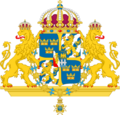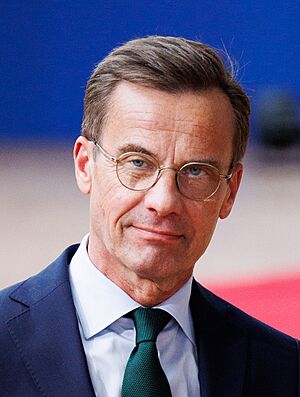Prime Minister of Sweden facts for kids
Quick facts for kids Prime Minister of Sweden |
|
|---|---|

|
|

|
|
| Executive branch of the Swedish Government | |
| Style | Mister Prime Minister (Swedish: Herr Statsminister) (informal) His Excellency (diplomatic) |
| Member of |
|
| Reports to | Riksdag |
| Residence | Sager House Harpsund |
| Seat | Rosenbad, Stockholm, Sweden |
| Nominator | Riksdag |
| Appointer | Speaker |
| Term length | 4 years (renewable) |
| Constituting instrument | 1974 Instrument of Government |
| Formation | 20 March 1876 |
| First holder | Louis Gerhard De Geer |
| Succession | Line of succession |
| Deputy | Deputy Prime Minister |
| Salary | 2,112,000 kr/US$ 203,076 annually |
The Prime Minister of Sweden (called statsminister in Swedish) is the main leader of the Swedish government. This person and their team of ministers, called the cabinet, are in charge of running the country. They must answer to the Parliament of Sweden, known as the Riksdag.
The Speaker of the Riksdag suggests who should be Prime Minister. Then, the Riksdag votes. The Prime Minister is chosen if most members do not vote against them. Elections for the Riksdag happen every four years.
The job of Prime Minister started in the 1800s. This happened as Sweden became more democratic. Before this, the King was the main leader. But some people, like Axel Oxenstierna, were very powerful advisors. They acted like a leader of the government. Today, the Prime Minister has the most important political role in Sweden.
The Prime Minister is the true head of the government. This is because Sweden's main law, the Instrument of Government, says that the government has the power to lead. The Prime Minister is the head of this government. The Prime Minister has two official homes: the Sager House and Harpsund.
Contents
History of the Prime Minister
For a long time, the King of Sweden was both the head of state and the head of government. Kings like Gustav I and Gustav III led the government directly. But many kings had strong advisors. These advisors sometimes acted as the real leaders. For example, Axel Oxenstierna was very important in building the Swedish Empire.
Before the Prime Minister job existed, the Lord High Chancellor was the closest thing to a government leader. This was especially true during the "Age of Liberty."
In 1809, new roles were created: the Prime Minister for Justice and the Prime Minister for Foreign Affairs. But these were just leaders of their departments. When the main Prime Minister job was created in 1876, these roles became regular ministers. The Minister for Foreign Affairs still kept the special title "Excellency."
After 1917, the King could no longer pick ministers on his own. He had to choose the leader of the biggest party in the Riksdag. Even though the law still said the King ruled, he had to follow the advice of his ministers. This meant the ministers started to use the King's powers.
In 1974, Sweden changed its main law again. This new law officially made the Parliament the main power. It also took away all political power from the King. This made the Prime Minister and the cabinet the true leaders of the country. This change made official what had been happening since 1917.
What the Prime Minister Does
The main law of Sweden says that the Prime Minister must choose a Deputy Prime Minister. This person takes over if the Prime Minister cannot do their job. If there is no Deputy Prime Minister, the oldest minister in the cabinet becomes the acting leader.
The Prime Minister's job in Sweden is very strong. Since 1975, the Prime Minister has been the real leader. Their powers are clearly written in the Instrument of Government. In other nearby countries like Denmark and Norway, the King is still the official leader. But in Sweden, the King has no political role. This was decided in 1971 by the main political parties.
How a Prime Minister is Chosen
Becoming Prime Minister
To choose a new Prime Minister, the speaker of the Riksdag talks with the leaders of all the political parties. Then, the Speaker suggests a person to the Riksdag.
The Riksdag then votes on the suggested person. The person becomes Prime Minister if fewer than 175 members vote "no." It does not matter how many vote "yes" or do not vote. This is like saying the majority of the Riksdag "tolerates" the choice.
After the Riksdag approves, the new Prime Minister must tell the Riksdag which ministers will be in their new government.
The official change of government happens at the Royal Palace. This is a meeting led by the King, currently Carl XVI Gustaf. At this meeting, the Speaker explains how the Prime Minister was chosen. The King then announces that the new government has started. This makes the new Prime Minister and their government official.
Leaving the Job
If a Prime Minister resigns, dies, or is forced out by the Riksdag, the Speaker asks them to stay on as a temporary government. This "caretaker government" stays until a new government is in place.
Other ministers do not need the Riksdag's approval. But they can be forced to resign by a "vote of no confidence." If the Prime Minister loses a vote of no confidence, the whole government falls. Then, the process to choose a new Prime Minister starts again. The Prime Minister can also decide to dissolve the Riksdag. This means new elections will be held.
Where the Prime Minister Works and Lives
Office and Homes
The government offices, including the Prime Minister's office, are in a building called Rosenbad. This building is in central Stockholm. It is right across the water from the Riksdag building.
Since 1995, the Sager House has been the private home of the Prime Minister. It was bought in 1991.
Harpsund, a large country house, has been used by the Prime Minister since 1953. It is in Flen Municipality. This house is also used for government meetings and informal talks. These talks happen between the government, businesses, and other groups in Sweden.
Salary
The salaries for the Prime Minister and other ministers are decided each year. A special committee of the Riksdag reviews them. Since January 1, 2022, the Prime Minister's monthly salary is 184,000 SEK.
Images for kids
-
The Rosenbad building has been the Prime Minister's Office since 1981.
See also
 In Spanish: Primer ministro de Suecia para niños
In Spanish: Primer ministro de Suecia para niños
- Deputy Prime Minister of Sweden
- Swedish governmental line of succession
- List of prime ministers of Sweden
- List of spouses of prime ministers of Sweden






